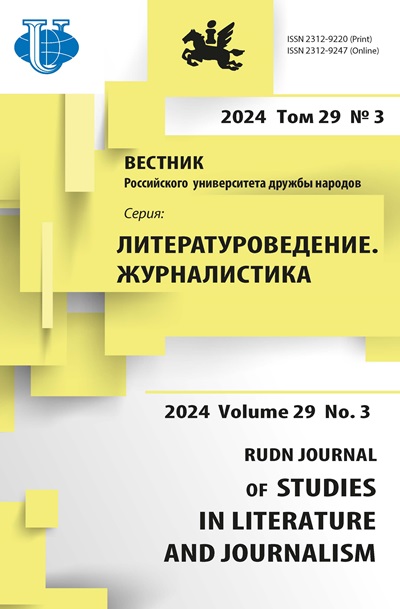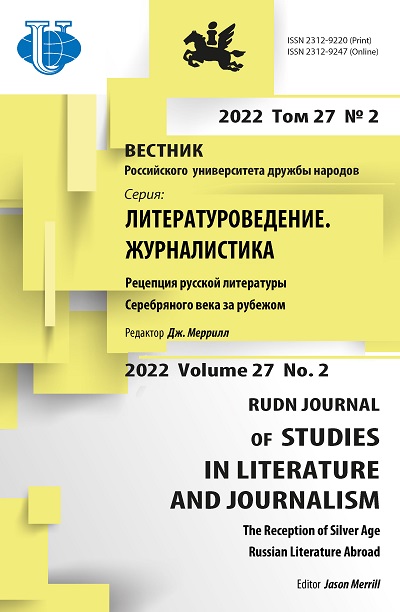Fedor Sologub in English-Language Anthologies: 1915-1950
- Authors: Merrill J.1
-
Affiliations:
- Michigan State University
- Issue: Vol 27, No 2 (2022): THE RECEPTION OF SILVER AGE RUSSIAN LITERATURE ABROAD
- Pages: 257-285
- Section: LITERARY CRITICISM
- URL: https://journals.rudn.ru/literary-criticism/article/view/31456
- DOI: https://doi.org/10.22363/2312-9220-2022-27-2-257-285
Cite item
Full Text
Abstract
The history of the reception of the Russian Symbolist movement in English begins in the 1890s. Readers in Great Britain and the United States could read about the Russian Symbolist Fedor Sologub long before any of his works were translated into English. During World War I and a parallel wave of interest in Russia, Sologub is one of the most popular Russian writers in the English-speaking world. Some of his poetry and prose works are translated into English and during the years 1915-1950 are included in no fewer than 28 Englishlanguage anthologies. During the first years of this period, almost all of his prose that is accessible to English readers is selected and translated by two translators, John Cournos and Stephen Graham. His poetry, on the other hand, is selected and translated by several translators over the course of this entire period. Anthologies with works by Sologub appear in two main waves: from 1915 until the middle of the 1920s, and in the 1940s after the outbreak of WWII. These anthologies demonstrate how Sologub was presented to English-speaking audiences during these years. This article examines English-language anthologies from this period, comparing what, if anything, is said about Sologub in their introductions to the works by Sologub they include. Some presented him as the quintessential decadent, while others tried to show the various sides of Sologub’s works. It is often the case in anthologies that the opinions of Sologub presented by editors are not supported by the works by Sologub these same editors selected for inclusion. The article ends with three bibliographical appendices listing Sologub’s anthologized poetry and prose and the anthologies that included them.
About the authors
Jason Merrill
Michigan State University
Author for correspondence.
Email: merril25@msu.edu
ORCID iD: 0000-0003-0753-813X
Ph.D., Professor of Russian
619 Red Cedar Rd., East Lansing, Michigan, 48864, USAReferences
- Anon. (1915). An American Fruit Farm: its Selection, Management for Profit and Pleasure. By Francis Newton Thorpe. (Putnam’s Sons, NY). Journal of the Royal Horticultural Society, (XLI) (part II).
- Anon. (1915, November 14). The Art of the Short Story in Russia. The New York Times, 443–446.
- Arshinova, I.V. (2018). Silver Age in “Anglo-Russian Literary Society Works”. Russkaya Literatura, (4), 91–96. (In Russ.)
- Azadovsky, K.M. (2020). Viennese Accent: Fedor Sologub and His Translator. Russkaya Literatura, (1), 122–161. (In Russ.)
- Babikov, A.A. (2018). Letter of V.V. Nabokov to Е.А. Malozemova. Literary Fact, (10), 385–392. (In Russ.)
- Balmont, C. (1898, July 2). Russia. The Athenaeum, (3688), 25–26.
- Barker, M.G. (1969). The Novels of Fedor Sologub (Ph.D. dissertation). Yale University.
- Beasley, R. (2012). Modernism’s Translations. The Oxford Handbook of Global Modernisms (pp. 551–570). NY: Oxford UP.
- Bechhofer, C.E. (1921, October 13). Russian Literature Today. Times Literary Supplement, 661.
- Bely, A. (1907). Masks in Decay. Kriticheskoe Obozrenie, (3), 27. (In Russian)
- Bogomolov, N.A. (2016). Letters of S.А. Sokolov and L.D. Ryndina to F. Sologub and А.N. Chebotarevskaya (1904–1915). Fedor Sologub: Research and Materials (pp. 140–237). Moscow: NLO. (In Russ.)
- Bowra, C.M. (1943). A Book of Russian Verse. London: Macmillan & Co., LTD.
- Bowra, C.M. (1949, April 2). Poets of Russia. Times Literary Supplement, 222.
- Bowring, J. (1821). Specimens of the Russian Poets with Preliminary Remarks and Biographical Notices. London: Hunter.
- Bowring, J. (1823). Specimens of the Russian Poets with Introductory Remarks: Part the Second. London: Whittaker.
- Bristol, E.C. (1960a, October). Fedor Sologub’s Postrevolutionary Poetry. The American Slavic and East European Review, (19.3), 414–422.
- Bristol, E.C. (1960b). The Lyric Poetry of Fedor Sologub (Ph.D. dissertation). University of California, Berkeley.
- Briusov, V. (1904, September 3). Russia. The Athenaeum, (4010), 312–314.
- Briusov, V. (1905, October 14). Russian Literature. The Athenaeum, (4068), 500–502.
- Brodsky, P.P. (1972). Fedor Sologub, Optimist of Death: A Thematic Analysis of His Short Prose and a Comparison with Selected German and American Authors (Ph.D. dissertation). University of California, Berkeley.
- Cournos, J. (1920, December 30). Russian Literature in Exile. Time Literary Supplement, 888.
- Cournos, J. (1935). Autobiography. NY: G.P. Putnam’s Sons.
- De Bogdanovitch, L. (1897, November, December 1896, January 1897). A Cursory Review of Russian Literature for the Year 1896. The Anglo-Russian Literary Society Proceedings, (16), 49–65.
- Deutsch, B., & Yarmolinsky, A. (1921, 1927). Modern Russian Poetry: An Anthology. New York: Harcourt, Brace.
- Field, A. (1961). The Created Legend: Sologub’s Symbolic Universe. The Slavic and East European Journal, (5.4), 341–349.
- Field, А. (1962). The Theatre of Two Wills: Sologub’s Plays. The Slavonic and East European Review, (41), 80–88.
- Filicheva, V.V. (2016). Additional Materials to Fedor Sologub’s Library Descriptions. Fedor Sologub: Research and Materials (pp. 710–732). Мoscow: NLO. (In Russ.)
- Forsyth, J. (1966). Introduction. Федор Сологуб: Мелкий бес / F. Sologub: Shabby Demon (pp. 1–5). Letchworth, UK: Bradda Books.
- Gamalova, N. (2020). Osip Mandelshtam in French Anthologies of Russian Poetry. Literatura (Vilnius), 62(2), 92–111. (In Russ.) https://doi.org/10.15388/Litera.2020.2.5
- Gasse, I. (2012). The British Reception of Early Soviet Fiction 1917–1934. Key Words: A Journal of Cultural Materialism, (10), 68–87.
- Gruppilion, B. (1907). Fedor Sologub. Masks in Decay. Pereval, (7), 54–56. (In Russ.)
- Guthrie, A.L. (1917). Garshin, Kuprin, Sologub and Other Short Stories. Russian Literature: A Study Outline (pp. 41–42). NY: H.W. Wilson Company.
- Hansen-Leve, A. (1999). Russian Symbolism. The System of Poetical Motifs. Early Symbolism. Saint-Petersburg: Akademichesky Proekt Publ. (In Russ.)
- Iliev, S.P. (1973). V. Briusov’s Articles in “The Athenaeum”. Briusovskie Chteniya 1971 (pp. 569–579). (In Russ.)
- Iliev, S.P. (1983). Valery Briusov’s Reviews of Russian Literature for “The Athenaeum” (1901–1906) (pp. 275–349). Briusovskie Chteniya, 1980. (In Russ.)
- Iliev, S.P. (1986). K.D. Balmont — an Observer of Russian Literature of the Late XIX Century. Blokovsky Sbornik, (7), 99–112. (In Russ.)
- Iliev, S.P. (1993). William Richard Morfill and Russian Symbolists (Balmont, Briusov, “Athenaeum” and “Vesy”). Studia Rossica Posnaniensia, (25), 33–40. (In Russ.)
- Ivanits, L.J. (1973). The Grotesque in F.K. Sologub’s Novel “The Petty Demon” (Ph.D. dissertation). The University of Wisconsin-Madison.
- Kalbouss, G. (1968). The Plays of Fjodor Sologub (Ph.D. dissertation). New York University.
- Korostelev, O.A., Efimov, M.V. (2013). “The Judge is Strict, but Just”: D. Mirsky’s Articles and Reviews in “The Slavonic Review” (1922–1929). Russkaya Literatura, (3), 199–232. (In Russ.)
- Kostka, Е. (1965). Heinrich Mann and Fedor Sologub. Rivista di letterature moderne e compare, (18.1), 245–258.
- Lodge, К. (2007). The Dedalus Book of Russian Decadence: Perversity, Despair and Collapse. Gardena, CA: Dedalus.
- Maslennikov, O. (1947). Fyodor Sologub. Columbia Dictionary of Modern European Literature (pp. 761–762). NY: Columbia University Press.
- Maude, A. (1917, December 13). The Treatment of Jews in Russia. The Times Literary Supplement, 606.
- May, R. (2000). Russian Literary Translation into English. Encyclopedia of Literary Translation into English. (Vol. 2, pp. 1204–1209). M-Z. London: Fitzroy Dearborn.
- Mirski, D.S. (1921, February). A Russian Letter. The Symbolists. The London Mercury, (16), 427–430.
- Mirski, D.S. (1922). The Literature of Bolshevik Russia. The London Mercury, (27), 276–285.
- Nabokov, V. (1944, January 17). Cabbage Soup and Caviar. The New Republic, 92–93.
- Pavlova, M.M. (1999). Fedor Sologub and A.N. Chebotarevskaya. Correspondence with А.А. Izmailov. Ezhegodnik rukopisnogo otdela puskinskogo doma na 1995 (pp. 194–293). Saint-Petersburg: Dmitry Bulanin Publ. (In Russ.)
- Poggioli, R. (1960). Fedor Sologub. The Poets of Russia, 1890–1930 (pp. 105–111). Cambridge, MA: Harvard University Press.
- Reeve, F.D. (1963). The Geometry of Prose. The Kenyon Review, (1), 9–25.
- Ronen, O. (1968). Toponyms of Fedor Sologub’s Tvorimaja Legenda. Die Welt der Slaven, (13), 307–316.
- Slonim, M. (1962). From Chekhov to the Revolution: Russian Literature 1900–1917. NY: Oxford UP.
- Rudzinsky, B.A. Selection of Russian Poetry. Oxford: Blackie and son Limited, 1917.
- Selver, P. (1917, 1919). Modern Russian Poetry: Texts and Translations. London: Kegan Paul, Trench, Trubner & Co., Ltd.
- Sologub, F. (1915, January 28). The World Colossus. Birzheviye Vedomosti, (14638), 3. (In Russ.)
- Sologub, F. (1916, April 1). On a Dim Day. Birzheviye Vedomosti, (15176), 2–3. (In Russ.)
- Sologub, F. (1962). The Little Demon. London: New English Library.
- Sologub, F. (1962). The Petty Demon. NY: Random House.
- Sologub, F. (1977). The Kiss of the Unborn and Other Stories by Fedor Sologub. Knoxville: University of Tennessee Press.
- Sologub, F. (1978). Bad Dreams. Ann Arbor: Ardis Press.
- Sologub, F. (1979). The Created Legend. Ann Arbor: Ardis Press, 1979.
- Sologub, F. (1997). Consolation and Selected Verse. Barbary Coast Books.
- Steklov, Yu.M. (1909). On Fedor Sologub’s Works. Literaturny Raspad: Kriticheskiy Sbornik (pp. 165–216, Book. 2). Saint-Petersburg: “ЕOS” Publ. (In Russ.)
- Strelnikova, A.B., Sysoeva, А.V. (2020) Fedor Sologub’s Collection of Stories “The Old House and Other Tales” in John Cournos’s Translation: Reception and Rivalry. Russkaya Literatura, (2), 122–131. (In Russ.)
- Struve, G. (1946). Histoire de la littérature russe (Paris, 1946) by M. Hofmann. Slavonic and East European Review, (25), 617–618.
- Tchougounova-Paulson, E.E. (2019). Chronology of the English Translations of Alexander Blok’s Works: History and Modernity. The New Philological Bulletin, 3 (50), 249–260. https://doi.org/10.24411/2072-9316-2019-00076
- Gorky, M., Andreyev, L., & Sologub, F. (Eds.). (1917). The Shield. NY: Alfred A. Knopf.
- Tikhomirova, Yu.A. (2014). Russian Classic Poetry in English-language Anthologies: Strategy of Representation. Siberian Journal of Philology, (3), 173–181. (In Russ.)
- Timenchik, R. (2015). The Last Poet: Akhmatova in the 60s. Мoscow. (Vol. 2). (In Russ.)
- Tverskoy, P.A. (1916). Vladimir G. Korolenko. Russian Review, II (5), 213–219.
- Vaninskaya, A. (2011). Kornei Chukovsky in Britain. Translation and Literature, (3), 373– 392.
- Williams, H. (1925, January 29). Russian Poetry. Times Literary Supplement [London, England], 68.
- Williams, H.W. (1914). Feodor Sologub. Russia of the Russians (pp. 213–216). London: Sir Isaac Pitman and Sons.
- Woodward, J.B. (1965). From Brjusov to Ajkhenvald: Attitudes to the Russian Theatre, 1902–1914. Canadian Slavonic Papers / Revue Canadienne des Slavistes, (7), 173–188.
- Yarmolinsky, A. (1949). A Treasury of Russian Verse. New York: The Macmillan company.
















